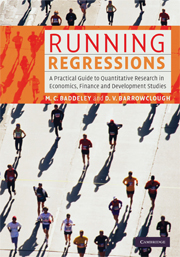 Running Regressions
Running Regressions Part III - Time-series econometrics
Published online by Cambridge University Press: 05 June 2014
Summary
In the previous parts, we have applied econometric techniques to both cross-sectional data and time-series data. Cross-sectional data has a spatial dimension and can be collected at different levels of disaggregation. It gives a ‘snapshot’ view from one point in time and will include observations for a number of different individuals, households, firms, regions or countries.
Conversely, time-series analysis focusses on one spatial ‘entity’ (e.g. a firm, a country or the world) and investigates how the behaviour of that entity changes over time. Time-series observations can be of any ‘periodicity’. The most commonly used are annual, quarterly, monthly or daily. In financial markets intra-day ‘high-frequency’ data is also collected, e.g. to record how asset prices change even from one second to the next.
Apart from the usual econometric problems discussed in Part II, the analysis of time-series data can be complicated by lags and structural breaks. There may also be time trends – both ‘deterministic’ (predictable) and ‘stochastic’ (random). These trends will generate the problem of ‘non-stationarity’.
In this part, we will investigate some of these complications. We will also introduce some econometric procedures designed specifically for the analysis of time-series data.
- Type
- Chapter
- Information
- Running RegressionsA Practical Guide to Quantitative Research in Economics, Finance and Development Studies, pp. 199 - 200Publisher: Cambridge University PressPrint publication year: 2009
- 1
- Cited by


